 |
Natural History of the
Canary Islands – part 2
by Teresa Farino and John Muddeman
The basal zone: malpaís or 'badlands'
 Euphorbia handiensis, Jandía, Fuerteventura© Teresa Farino Euphorbia handiensis, Jandía, Fuerteventura© Teresa Farino
PRINCIPAL HABITATS
The principal habitats of the Canary Islands are dictated primarily by climate and altitude. In essence, distinct bands of vegetation have developed at different altitudes, the height at which these occur varying according to whether they are exposed to the north-easterly alisios or lie in the rain shadow.
Cardonal-Tabaibal
The Basal Zone - often called malpaís, or 'badlands', and much affected by the recent rash of new tourist resorts and banana plantations - encompasses the hottest, driest regions of all the islands. It extends from sea level to around 400 m on north-facing slopes and up to 700 m on south-facing slopes, thus covering the larger part of the eastern isles of Fuerteventura and Lanzarote. The principal vegetation type of this Basal Zone is referred to as Cardonal-Tabaibal, named after the dominant shrubs, although in the eastern Canaries great expanses of stony and sandy plains - known locally as jables - are also present, harbouring similar plants to those found growing in coastal sands.
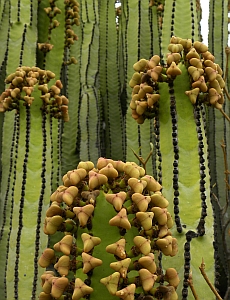 Euphorbia canariensis© Teresa Farino Euphorbia canariensis© Teresa Farino
Cardón is the local name for Euphorbia canariensis, a succulent spurge characterised by great clumps of columnar stems up to 3 m tall, which is surely one of the most memorable plants of all seven islands. In essence, the Cardón has adapted to the lack of available water in exactly the same way as the New World cacti, in a superb example of convergent evolution.
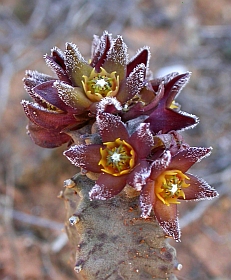 Caralluma burchardii© Teresa FarinoThe extensive root system absorbs water rapidly when it rains, storing it in the stems for use during drought periods, while the leaves have been reduced to short, curved spines to avoid water loss by transpiration, such that photosynthesis is carried out exclusively by the stems. Caralluma burchardii© Teresa FarinoThe extensive root system absorbs water rapidly when it rains, storing it in the stems for use during drought periods, while the leaves have been reduced to short, curved spines to avoid water loss by transpiration, such that photosynthesis is carried out exclusively by the stems.
This is obviously such a successful strategy in arid conditions that several other Canary plants have opted for a similar way of life, including the leafless spurge Euphorbia aphylla, the very spiny Euphorbia handiensis, the small, cactus-like Caralluma burchardii (family Asclepiadaceae) and several related species of Ceropegia.
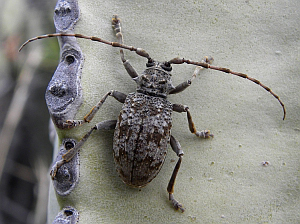 Lepromoris gibba© Teresa Farino Lepromoris gibba© Teresa Farino
The Tabaibas also belong to the genus Euphorbia, but are leafy shrubs - often known as tree spurges - displaying a much lesser degree of succulence, and tending to shed their leaves in times of drought. The most widespread species are Euphorbia balsamifera, E. lamarckii (formerly E. obtusifolia/E. broussonetii) and E. regis-jubae, often growing in conjunction with Kleinia neriifolia, which is morphologically very similar but belongs to the daisy family (Compositae), and the distinctive Plocama pendula (Rubiaceae), a Canary endemic genus, with long drooping branches.
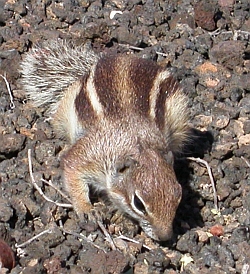 Barbary Ground Squirrel Barbary Ground Squirrel
Atlantoxerus getulus© Teresa Farino
Typical invertebrates of the Cardonal-Tabaibal include the Barbary Spurge Hawkmoth (Hyles tithymali), whose caterpillars feed on the leaves of the various spurges; by the time they are ready to pupate, these creatures look like fat, black and red sausages, some 8 cm long. The endemic longhorn beetles Lepromoris gibba and Stenidea albida both have larvae that develop exclusively within the dead stems of the Cardón, while the spectacular, rather spiny mantis Blepharopsis mendica - up to 6 cm long and also found in North Africa - may be found lurking among the branches of the tree-spurges, where it is surprisingly well camouflaged.
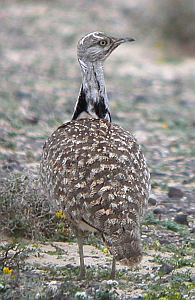 Houbara Bustard Houbara Bustard
Chlamydotis undulata fuerteventurae© John MuddemanSuch hot, dry habitats also find favour with a wide range of endemic reptiles - lizards of the genus Gallotia, geckos and skinks - as well as with the endemic Canary Shrew, and the introduced Barbary Ground Squirrel (Atlantoxerus getulus), thus far confined to Fuerteventura.
The most distinguished bird of the Basal Zone is undeniably the Canary endemic race of Houbara Bustard (Chlamydotis undulata fuerteventurae), the largest bird in the Canaries, standing around 60cm tall. It occurs exclusively in the extensive arid jables of Fuerteventura and Lanzarote, where it is threatened with loss of habitat owing to the relentless construction of tourist facilities, and its total population does probably not exceed 600 individuals.
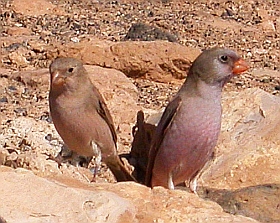 Trumpeter Finches Trumpeter Finches
Bucanetes githagineus amantum© Teresa Farino Like all bustards, Houbaras are ground-nesting birds, so are very much at home in these sparsely vegetated habitats, and are also willing to use their long legs to good effect by running away when threatened, rather than taking to the air. They are omnivores, feeding on seeds, small lizards and invertebrates.
The Cream-coloured Courser (Cursorius cursor) is almost impossible to detect if it is not moving, so well does its sand-coloured plumage blend in with its habitat, but with a bit of patience, small groups can be detected sprinting around in the open, arid plains of the eastern Canaries, like miniature roadrunners. The archipelago represents the principal European breeding locality for this medium-sized wader, harbouring some 2,000 individuals; it is considerably more common on Fuerteventura than Lanzarote and has occasionally bred in southern Tenerife.
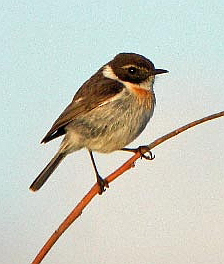 Male Canary Islands Stonechat Male Canary Islands Stonechat
Saxicola dacotae© John Muddeman
Other birds characteristic of the Basal Zone include the endemic Desert Grey Shrike (Lanius (excubitor) koenigi), the ever-attractive Hoopoe (Upupa epops), Berthelot's Pipit and Canary endemic subspecies of Spectacled (Sylvia conspicillata orbitalis) and Sardinian Warblers (S. melanocephala leucogastra), as well as the introduced Barbary Partridge (Alectoris barbara koenigi). Stone Curlews, or Eurasian Thick-knees, (Burhinus oedicnemus) are represented by two endemic races: distinctus in the central and western islands and insularum in the east of the archipelago, while the Canary endemic races of Trumpeter Finch (Bucanetes githagineus amantum) and Lesser Short-toed Lark (Calandrella rufescens polatzeki) are both most abundant on Fuerteventura and Lanzarote. The Canary endemic subspecies of Egyptian Vulture (Neophron percnopterus majorensis), which has suffered serious declines in recent years, nowadays breed only on Fuerteventura, as do the Canary population of Black-bellied Sandgrouse (Pterocles orientalis) and the endemic Canary Islands Stonechat.
|